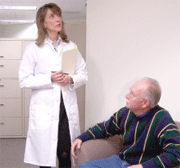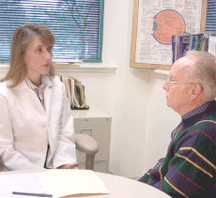 Optometrists must often inform patients and their families about a serious diagnosisone that may result in blindness, loss of visual function, increased dependency, change or loss of career, or financial hardship.
Optometrists must often inform patients and their families about a serious diagnosisone that may result in blindness, loss of visual function, increased dependency, change or loss of career, or financial hardship.
Breaking this news to the patient is never easy. Even the most compassionate professionals have agonized over how to tell patients bad news. Some handle this task poorlyhiding behind medical jargon, delegating the task to employees, prevaricating, or being overly optimistic. Other reasons for discomfort include inexperience, lack of sensitivity, and problems with certain patients.
Even if you refer the patient to a tertiary-level practitioner, youre the one whom patients will ask such questions as: Why am I being referred? What will happen to my vision? Is this condition treatable? Will I go blind?
Chairside manner is not something most of us are simply born with. But, today, educators believe that the skill of telling a patient bad news properly can be learned. To that end, this first installment of this new series, Role Playing, offers 10 simple steps to follow:
1. Never lie to the patient.
The laws of informed consent demand this, as well as the ethical requirements of honesty. It takes years of experience and maturity to be able to say to a patient, I dont know.
Discussing bad news requires a fine balance between optimism, pessimism and, in some cases, admitting the inability to predict the future course of a disease. Modern technology and pharmacology have permitted us to do things that were unthinkable many years ago. As a result, both the patient and the optometrist may experience a sense of failure if the condition is not cured. You may find yourself saying, In spite of closely monitoring and changing medications, the pressure continues to rise and the fields are getting worse.
Also, as a general rule, do not delay in telling patients their diagnosis. Only the need for additional tests or for having a family member present should be a cause for delay.
The unspoken question from the patient is, What should I do about it, and when? This means that you must have a plan in mind. It may involve medical therapy, optical devices, further testing, or referral to a tertiary-level practitioner. Have this information ready beforehand.
2. Choose the proper setting.
Uninterrupted privacy shows respect for the patient and gives patients the opportunity to freely express emotions and to ask questions. A crowded waiting room, a hallway, or a telephone call are not the venues to discuss bad news with patients. Use the examination room or your private office, and tell your staff to avoid interruptions.
In addition:
Sit down with the patient. Studies show that the patients impression of the time spent and the doctors compassion are greater when the doctor is sitting.1
Sit close to the patient. In one experiment, interns were told to give a diagnosis to patients they had not previously seen.2 (The patient, unknown to the interns, was an actor, and the interaction was being observed.) The interns were instructed to sit in a chair with wheels that was placed at a distance from the examination chair. The observers noted that interns sat closer to patients to whom they gave good news than to those they gave bad news.
Like anyone, doctors have a natural inclination to separate themselves from bad news. But, we must consciously overcome that inclination when speaking with patients.
3. Slow the transmission.
Prepare the patient for bad news by setting the tone of the conversation. Give patients a warning shot to let them know that bad news is coming: The news is not good.
An example: I have looked at your tests, Mrs. Smith, and Im afraid the results are not what I had hoped for. It seems the recent decrease of your vision cannot be restored with a change in your prescription. Theres a problem in the retinathe part of the back of the eye that captures the picture; it acts like the film in a camera. The central part isnt working as well as it did. Do you follow me?
Dont wait until the end of your explanation to ask if the patient has any questions; do this frequently during the conversation, especially as you add new information.
4. Use laymans terms.
Dont hide behind medical jargon. Also, frame the diagnosis with some ameliorating comment. Your condition is called macular degeneration. What this means is that the central part of your vision has undergone some uncorrectable, degenerative changes. Fortunately, the type you have is the slow type, so we dont expect a radical change in your vision as time passes.
Or: Mr. Smith, my examination shows you have a tear in the retina. Fortunately, it is in the periphery and, once treated, it should cause no visual problems. Often, patients will not understand the treatable aspects of conditions. For example, some might think that a diagnosis of cataract means a life of blindness.
Regardless of the condition, there is always a way to present the bad news so that it doesnt sound as bad it could be, yet still sounds serious. You might point out that the condition can be corrected or treated, or that one eye isnt affected or affected as much as the other.
5. Show empathy.
There is an old saying in health care: Doctors cure rarely, alleviate often, and comfort always. Comforting is very much a part of delivering unwelcome news. Yet empathy alone, while necessary, is not sufficient. For example: I feel badly having to tell you this, but over the years Ive had many patients with this condition. They continue to enjoy useful vision and can still read and work.
Take note:
Avoid saying, Im sorry. Though well intentioned, this often is interpreted as guilt.
Avoid any attempt at humor, such as, Mrs. Jones, Ive got good news and bad news...
When discussing treatment plans, use we as in: What were going to do is give you the very best correction at this time. Then, were going to monitor you frequently to make sure you continue to have the best vision possible at all times. This emphasizes your involvement and the patients participation.
How to Break Bad News: DOs and DON"Ts DONT break bad news in a public area. DONT remain standing. DONT distance yourself from the patient. DONT avoid eye contact. DONT avoid questions. DONT hide behind medical jargon. DO speak in private. DO sit down with the patient. DO sit near the patient. DO make eye contact. DO pause and ask if the patient understands. DO speak in plain language.


6. Inquire about the patients concerns.
Ask open-ended questions: I know this comes as a shock. Are there any questions you have? Tell me what youre thinking.
This is when the patient will disclose his or her fears. Handle these with care. If needed, schedule another visit in a few days. This gives the patient time to digest what youve said. Explain that a family member is welcome at the follow-up visit.
The answers to open-ended questions may surprise you. Rather than vision itself, sometimes a patients concerns are cosmetic, work- or school-related, or may involve interpersonal relations. After I diagnosed one patient with a marginal corneal ulcer, she began to cry. An open-ended question brought out her concern: She was a few months pregnant and was worried about passing the condition on to her unborn child.
Another patient began to cry after I told her that her decreased vision was due to a cataract. Between sobs, she said she should have been a better daughter to her now-deceased mother. She viewed blindness as religious retribution.
Remember that bad news is situational. An elderly woman told that she has rapidly progressing glaucoma may not be as distraught as a young boy told that he has to wear glasses. When hearing bad news, patients tend to prefer a discussion that is focused on their emotions and concerns first, and the condition itself second.3
7. Discuss the game plan with the patient.
This includes the prognosis, treatment, and referral.
The changes Ive made to your correction now give you the best vision possible. I want to see you in six months to make sure you continue to have the correction that will give you the best vision.
When making treatment decisions, schedule another appointment in the next few days to give the patient time to absorb the bad news.
8. Leave room for hope.
If one has to have macular degeneration, you have the best type: slow-changing. From what I can judge now, this wont affect any activities for a long time.
Or: At this time, the cataract is decreasing vision in one eye only, and it shouldnt affect driving or watching television.
Or, consider this: I know youre going to go home and think about what Ive told you. Remember, I want you to call me with any questions you haveat any time. Let me write my home telephone number on the back of my card if you think of anything after hours. Such a suggestion will make the patient feel special. I used this for years and only a few patients called me at home for an answer.
9. Be willing to refer.
If the prognosis is dire, especially if the patient appears to be in denial, offer to suggest someone to whom they can go for a second opinion.
Patients may be reluctant to ask this for fear of insulting you by doubting your word. By offering this, you express confidence in your diagnosis and provide comfort to the patient.
10. Listen to the patient.
Listening also involves watching patients for clues as to how they are reacting to the bad news. A patient might verbalize one feeling, but posture and expression tell you another story.
Listening also has a therapeutic effect on patients. Often, for the optometrist, it is little more than paraphrasing or summarizing the patients concerns.
One optometrist told me that when discussing a systemic disease that has serious ocular consequences, she delivers the bad news, provides some follow-up information, and then stops and says to the patient: I find with some patients, the shock of such news prevents them from understanding all the things Ive said. Can you tell me, in your own words, some of the things Ive just outlined and how you feel about each?
With this technique, she determines how well the patient retains the information, listens for questions, and gauges the patients emotional reaction. Her aim is to have an educatedand compliantpatient.
There are certain fundamental skills needed when communicating bad news. Even experienced clinicians would do well to think about these principles so that the procedure of giving bad news is organized, comfortable, shows kindness to patients, and helps them to be compliant with your advice.
Now retired, Dr. Rosenwasser co-authored How To Give Your Patients Bad News with his daughter Beth J. Rosenwasser, M.Ed., L.P.C., a clinical therapist (www.HowToGiveYourPatientsBadNews.com). He has taught contact lens fitting, pathology, and patient communications. He has also written extensively on malpractice and office practice.
1. Strasser F, Palmer JL, Willey J, et al. Impact of physician sitting versus standing during inpatient oncology consultations: patients preference and perception of compassion and duration. A randomized controlled trial. J Pain Symptom Manage 2005 May;29(5):489-97.
2. Roth CS, Watson KV, Harris IB. A communication assessment and skill-building exercise (CASE) for first-year residents. Acad Med 2002 Jul;77(7):746-7.
3. Schmid Mast M, Kindlimann A, Langewitz W. Recipients perspective on breaking bad news: how you put it really makes a difference. Patient Educ Couns 2005 Sep;58(3):244-51.

